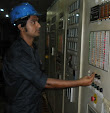Basic Laws of Thermocouple
For practical purposes, an application engineer must be concerned with three basic laws which establish the fundamental rules for proper connection of the thermocouples. It should be stressed, however, that an electronic interface circuit must always be connected to two identical conductors.
Law No. 1: A thermoelectric current cannot be established in a homogeneous circuit by heat alone.
 |
| 1st law |
This law provides that a nonhomogeneous material is required for the generation of the Seebeck potential. If a conductor is homogeneous, regardless of the temper- ature distribution along its length, the resulting voltage is zero. The junctions of two dissimilar conductors provide a condition for voltage generation.
Law No. 2: The algebraic sum of the thermoelectric forces in a circuit com-posed of any number and combination of dissimilar materials is zero if all junctions are at a uniform temperature.
 |
| 2nd law |
The law provides that an additional material C can be inserted into any arm of the thermoelectric loop without affecting the resulting voltage V1 as long as both additional joints are at the same temperature (T3 in Fig. 16.15A). There is no limitation on the number of inserted conductors, as long as both contacts for each insertion are at the same temperature. This implies that an interface circuit must be attached in such a manner as to assure a uniform temperature for both contacts. Another consequence of the law is that thermoelectric joints may be formed by any technique, even if an additional intermediate material is involved (such as solder). The joints may be formed by welding, soldering, twisting, fusion, and so on without affecting the accuracy of the Seebeck voltage. The law also provides a rule of additive materials (Fig. 16.15B): If thermoelectric voltages (V1 and V2) of two conductors (B and C) with respect to a reference conductor (A) are known, the voltage of a combination of these two conductors is the algebraic sum of their voltages against the reference conductor.
Law No. 3: If two junctions at temperatures T1 and T2 produce Seebeck voltage V2, and temperatures T2 and T3 produce voltage V1, then temperatures T1 and T3 will produce V3 =V1 +V2 .
 |
| 3rd law |
This is sometimes called the law of intermediate temperatures. The law allows us to calibrate a thermocouple at one temperature interval and then to use it at another interval. It also provides that extension wires of the same combination may be inserted into the loop without affecting the accuracy.
Laws 1–3 provide for numerous practical circuits where thermocouples can be used in a great variety of combinations. They can be arranged to measure the average temperature of an object, to measure the differential temperature between two objects, and to use other than thermocouple sensors for the reference junctions and so forth. It should be noted that thermoelectric voltage is quite small and the sensors, especially with long connecting wires, are susceptible to various transmitted interferences. A general guideline for the noise reduction can be found in Section 5.9 of Chapter 5. To increase the output signal, several thermocouples may be connected in series, while all reference junctions and all measuring junctions are maintained at the respective temperatures. Such an arrangement is called a thermopile (like piling up several thermocouples). Traditionally, the reference junctions are called cold and the measuring junctions are called hot. Figure 16.16A shows an equivalent circuit for a thermocouple and a thermopile. It consists of a voltage source and a serial resistor. The voltage sources represent the hot (eb) and cold (ec) Seebeck potentials and the combined voltage Vp has a magnitude which is function of a temperature differential. The terminals of the circuit are assumed to be fabricated of the same material—iron in this example.








